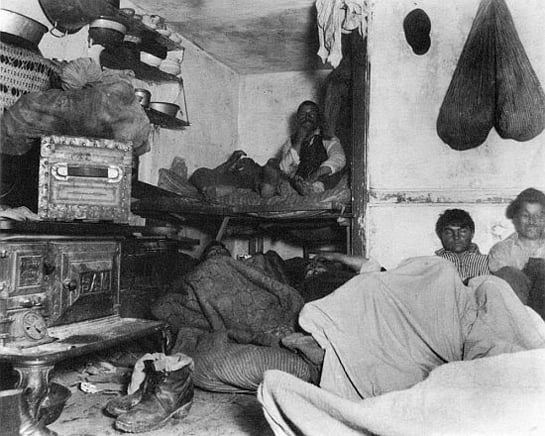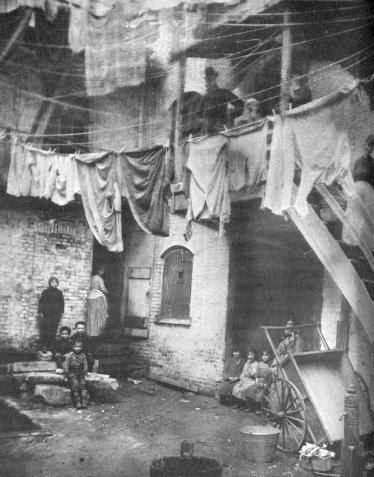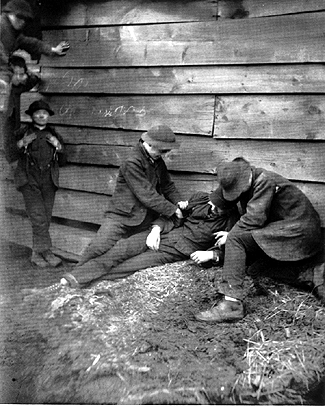
From NPR, "Jacob Riis: Shedding Light On NYC's 'Other Half,'" by Robert Siegel, on 30 June 2008:Through photos and writings documenting poverty in New York City in the late 19th century, a Danish immigrant became a famous campaigner against slum housing. Two new books tell the story of Jacob Riis, a social reformer and natural showman.
Imagine it's 1888. New York City. The Lower East Side is the most densely populated place on Earth: Block after block of tenements house the working-poor immigrants of the city, including Italians, Irish, Germans, Jews, Czechs and Chinese.
Imagine the darkness of an unlit corridor in one of those tenements, a corridor that opens onto windowless rooms, 10 feet square, where entire families live and might even work — sewing, or rolling cigars.
Out of the darkness, a door opens. A man with a Danish accent leads a team of amateur photographers, who are accompanied by a policeman. They position their camera on a tripod and ignite a mixture of magnesium and potassium chlorate powder. A flash explodes, illuminating their squalor.

It would take the photographers a few minutes to reload that early ancestor of the flash bulb. And then, on to another tenement scene.
And despite the blackness of a room or an unlit street, a picture is taken, a document of urban poverty.
In the late 1880s, a New York City police reporter named Jacob Riis took pictures that way in lower Manhattan.

'5 Cents A Spot'
One of Riis' most famous photos was taken on Bayard Street. It's called "5 Cents a Spot," which shows a room full of people bedding down for the night. (A "spot" meant a place on the floor.) They must have been shocked. Magnesium flash powder was something new. It was developed in Germany in 1887. Riis' burst of light must have been a stunning surprise, but it made the dim, airless lives of the poor visible to the middle class.
In public slideshows and in his book, How the Other Half Lives, Riis — who was born in Ribe, Denmark — used those images and his descriptions to jar the conscience of prosperous, native-born Americans.

A few days ago, we took a walk with Bonnie Yochelson and Daniel Czitrom, co-authors of Rediscovering Jacob Riis, through Mulberry Street. The neighborhood is recently gentrified, but this was where Riis campaigned against the housing conditions of the day.
"You can still see the really small size of the building lots," says Czitrom, who is a historian. "The typical building lot in New York for a tenement was 25 feet wide and 100 feet deep going back," and the buildings often took up the entire lot, he says.

No Light Or Air
So-called rear tenements, built behind other tenements, would have no access to light or air, and all the rooms were interior rooms, Czitrom says
A court decision from that era essentially said there is no right to light or air for a renter or an owner, he says. "So the idea that you have a right to a window or the right to some breathing space was not a legal right that anyone recognized until much later," Czitrom says.
Riis thought of himself as a writer, and he was evidently a gripping storyteller in the lectures he gave to accompany his lantern slideshows.
Yochelson, a curator at the Museum of the City of New York, says Riis was a passionate reformer, but he was also very conservative. He believed that Protestant philanthropy and the self-restraint of ethical landlords was the best remedy — not the government. And he was very much a product of his time.

A Slum Tour
"Riis organized his most famous book, which was a best-seller and launched his career as a reformer — How the Other Half Lives — as a kind of a slum tour, going neighborhood by neighborhood, describing ethnic group by ethnic group," Yochelson says. "That was a pre-established literary genre, which he was borrowing. It had a lot of entertainment value. 'Come see the colorful Italians and the mystifying Chinese.'
"And there was the sense of he was playing on the ... entertainment value of these stereotypes," she says. "So on the one hand, there was a certain racial typology that he believed in. But it was also popular culture, and he abandoned that after How the Other Half Lives."
Czitrom adds, "One of the things that makes Riis so fascinating are these contradictions in his work. I see Riis more as a transitional figure. He's somebody that did bring with him those stereotypes and sort of racialized thinking of the day, but he's also somebody that began insisting on the importance of environment. Or, as he put it at one point, it's the squalid houses that make for squalid people."
Rediscovering Jacob Riis, the book that Yochelson and Czitrom collaborated on, is one of two new books about Riis. The Other Half is the title of a new biography by Tom Buk-Swienty, a Danish historian and former newspaper correspondent in the United States.

Poverty Firsthand
Riis was once one of the most famous men in America: a close friend and confidante of President Theodore Roosevelt and the epitome of the immigrant made good — good, in his case, being measured by political and social influence, not by wealth.
But Buk-Swienty says that didn't impress the Danes back in Riis' hometown of Ribe, who viewed anyone who seemed well-off as being so at their expense.
Buk-Swienty tells the story of how young Riis, the underachieving son of a schoolmaster, set off for America when the girl he adored turned down his proposal of marriage.

Riis worked in the U.S. as a carpenter; in the financial panic of 1873, he experienced unemployment firsthand.
"He himself experienced extreme poverty," Buk-Swienty says. "There was a time where he just didn't have a place to sleep. He had no money. He was totally penniless."
The experience led Riis to feel empathy with New York's poor immigrants, Buk-Swienty says.
"He could write about them because he knew what they were going through," he says.
Poverty struck Riis as abnormal — even for the various immigrant groups whom he regarded as exotic. When he lived in New York City, about 40 percent of the population was foreign-born. It's just about the same share today.

A Personal Transformation
Millions of immigrants were in the process of becoming American.
Buk-Swienty studied Riis' diaries and says he found the moment when the Danish carpenter, not yet a reporter, became an American, mentally. He says it happened when Riis learned that the girl back home, the one he had been pining for, had gotten engaged to a Danish military hero.
"He was shocked," Buk-Swienty says. "That came for him as a total surprise, and his world, you could say, went dark for a few days."

Riis wrote about his sorrow in Danish, but a few days later, he began to write his diary in English. "It's very remarkable," Buk-Swienty says. "You can see that something is changing in this man."
Riis was a social reformer who was also, with his slideshows and lectures, a natural showman.
"I do think that Riis is the first muckraker," Czitrom says. "I think he represents the beginning of a sort of progressive sensibility ... Riis believed that it was important, that it was crucial, to try to rouse the conscience of the public, to appeal to the conscience. This belief that if we could simply expose conditions, if people simply knew how bad things were, they would rise up and change them." (source: NPR)

No comments:
Post a Comment